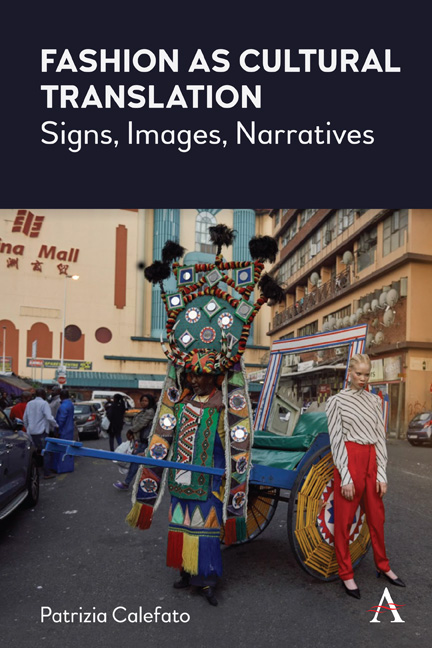Book contents
- Frontmatter
- Contents
- Introduction: Fashion as Cultural Translation in the Hyperconnected World
- Supplement to the Introduction: Fashion, the Hyperconnected World and Coronavirus
- 1 Time
- 2 Spaces
- 3 Fashion as Cultural Tradition: Italian Style
- 4 Fashion as Cultural Translation
- 5 Clothed Bodies
- 6 The Body as Text
- 7 Humans and Beyond
- 8 Fashion and the ‘Second Nature’
- 9 Fashion, Communication and Converging Media
- 10 Fashion Narratives in Visual Culture
- Conclusions: Fashion as an Idea about the Future
- References
- Index
5 - Clothed Bodies
Published online by Cambridge University Press: 18 February 2021
- Frontmatter
- Contents
- Introduction: Fashion as Cultural Translation in the Hyperconnected World
- Supplement to the Introduction: Fashion, the Hyperconnected World and Coronavirus
- 1 Time
- 2 Spaces
- 3 Fashion as Cultural Tradition: Italian Style
- 4 Fashion as Cultural Translation
- 5 Clothed Bodies
- 6 The Body as Text
- 7 Humans and Beyond
- 8 Fashion and the ‘Second Nature’
- 9 Fashion, Communication and Converging Media
- 10 Fashion Narratives in Visual Culture
- Conclusions: Fashion as an Idea about the Future
- References
- Index
Summary
Clothed in Signs
This chapter considers the clothed body within the sociocultural system of fashion. It looks at the relationship between the body and identity, understood as gender identity as well as a cultural identity within the global contemporary culture, within which the signs of clothing can often become – as in the case of the veil from the previous chapter – opportunities for conflict or cultural translation. This chapter looks at the social meanings of practices of body modification, which range from aesthetic surgery to permanent modifications (piercing, tattoos). Finally, it analyses the way in which the body of the model and the body of fashion – and its stereotypes – operate in the social imagination, pushing the body towards its own limits, for example, to pathologies such as anorexia.
With society, the body is always clothed. The ‘naked’ body does not really exist because it is always covered in signs: shaved, tanned, undressed under see-through fabrics, marked by wrinkles and scars. The clothed body is the external image which each of us displays to others. Above all, it is a cultural text made of clothing, accessories, jewellery, hairstyles, make-up, tattoos and decorations. These signs contain other social meanings, tales and senses which forge the social meaning of the body in the world.
Roland Barthes uses the term ‘dress’ to define the manifestations of ‘costume’ and ‘clothing’. While the former represents an essentially social reality, the latter stands for an individual reality through which the individual translates the general institution of costume on their body (Barthes 2006, 9). The phenomena of clothing include, according to Barthes, particular elements such as the sizes of garments, their level of wear and tear, tidiness and cleanliness, partial flaws, and use flaws such as unaligned buttons, unworn sleeves, creases and everything else which concerns the way in which individuals wear clothing. Instead, costume phenomena include social practices such as the ritualisation of colours, the use of black for mourning in the West, the differences between menswear and womenswear, and the features which distinguish clothes for children from clothes for adults.
Fashion is a phenomenon of costume because it is determined socially and through communication. It is also a sense-making system through which both individual and collective representations of the body and identity are produced.
- Type
- Chapter
- Information
- Fashion as Cultural TranslationSigns, Images, Narratives, pp. 43 - 54Publisher: Anthem PressPrint publication year: 2021



